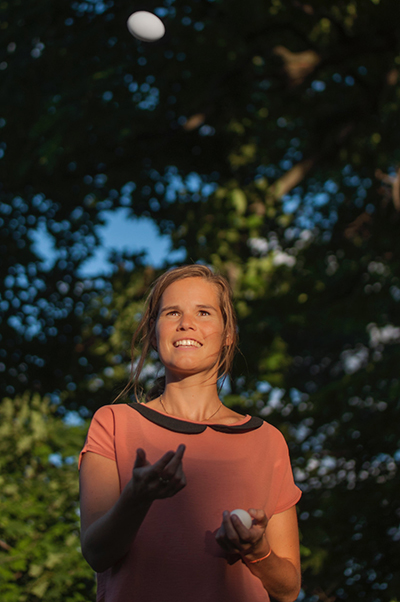Which came first – the chicken or the egg? A common conundrum, certainly. But UA’s latest Ph.D. student graduating with training in biomimicry says, in a nutshell (or an eggshell, if you like), that she is more interested in the egg.
Daphne Fecheyr-Lippens becomes the third member of the inaugural class of fellows to enter the world’s first Ph.D.-level training program in biomimicry by graduating this December. Fecheyr-Lippens started the fellowship in 2012 with Dr. Bill Hsiung and Dr. Emily Kennedy, both of whom graduated in May 2017. With her research, Fecheyr-Lippens seeks to understand how biomimicry can be implemented to solve challenges from fundamental research and development to building collaborative organizations.
Nature's lessons
A rapidly growing field, biomimicry is the practice of learning from nature and emulating its forms, processes and systems to solve human problems and drive innovation. Through our Integrated Bioscience Program and the Biomimicry Research and Innovation Center, UA is the only place in the world offering Ph.D. training in biomimicry. The platform embeds Ph.D. Fellows in the R&D of their corporate sponsors while they simultaneously work on their Ph.D. research. Fecheyr-Lippens completed the five-year curriculum, which includes part-time work with her sponsor, Parker Hannifin, arranged by fellowship program partner Great Lakes Biomimicry.
Hailing from Belgium, Fecheyr-Lippens did her undergraduate and master’s studies at University of Ghent, where she did research on the bacterial production of nanoparticles for use in wastewater treatment.
“Although I started my studies because I wanted to invent the cure against cancer,” said Fecheyr-Lippens, “I soon realized my deeper interests and true life-vision concerned environmental issues. One of the reasons of my mindset shift was the discovery of biomimicry.” She heard Janine Benyus, co-founder of the Biomimicry Institute, speak in Brussels, and that was it. Fecheyr-Lippens applied, was accepted and moved to Akron. “The moment I started reading about biomimicry, I got the feeling it would change my life, that I found something where I fit it.”
Being able to use Parker Hannifin’s progressive research lab were highlights, she said. It was at Parker Hannifin where she completed research on eggshell particles and their usage for UV-protection.
Eggshells repurposed
Chicken eggshell waste from manufacturing plants and food processing is currently generated at enormous amounts of several tons per day, according to their research article published in the February 2017 issue of Sustainability. Most eggshell waste is discarded because further processing is too expensive and cumbersome, and unprocessed eggshells are considered useless. The main objective of their study was to find an environmentally and economically appealing use of waste chicken eggshells by turning them into valuable UV-additives, which can be used to protect against photodegradation.
“I would say that I’ve gained the experience to apply biomimicry thinking on any kind of challenge, be it a product design, urban challenge or social innovation, and having enough leverage to share this with the rest of the world through articles, blogs and workshops,” said Fecheyr-Lippens when asked to consider what was the biggest impact of her biomimicry training.
“Biomimicry has become an everyday problem-solving tool, and the more people know about it and use it, the more impact we eventually might have to make all of our innovations more nature-aligned.”
Now residing in Portland, Ore., Fecheyr-Lippens is already focused on the next problem she hopes to solve.
“Making humans more empathy-driven and environmentally conscious,” Fecheyr-Lippens noted. “Caring for themselves and others, including our planet. Why put money-making, ego-tapping and efficiency/output above well-being and social connection? If we all slightly increase our humility and make decisions based on their impact, we would be able to collectively solve a whole lot of our current global issues.”
Media contact: Lisa Craig, 330-972-7429 or lmc91@uakron.edu.

Daphne Fecheyr-Lippens has fun tossing eggs, the focus of her Ph.D. research.
